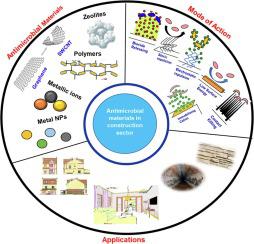Progress in Materials Science ( IF 33.6 ) Pub Date : 2022-12-17 , DOI: 10.1016/j.pmatsci.2022.101065 S.K. Kirthika , Gaurav Goel , Allan Matthews , Saurav Goel

|
Microbes can influence the durability of civil engineering structures. Damage caused by microbes (known as biodeterioration) results in compromised structural integrity causing adverse effects on economic and social wellbeing. One key example is that of microbiologically induced concrete corrosion (MICC) due to the bacteria in concrete sewerage pipes which leads to reduced lifespan of sewer pipes. Antimicrobial materials provide a biocidal approach for eradicating the microbes either by inhibiting their growth, or by actively killing them. An ideal antimicrobial material should possess qualities such as sustainability, durability, eco-friendliness, economic viability to avoid the growing issue of antimicrobial resistance (AMR). The literature covering these topics vital to the construction sector is rather scarce. Therefore, this review paper summarises various types of antimicrobial materials currently used in the construction sector detailing their mode of biocidal activity, and their application in structures. This paper also addresses recent developments, demerits and future scope that may aid in employing them expeditiously in the construction sector, particularly to benefit plumbing, and sanitation used in hospitals and high traffic areas and public places including airports, schools and other educational establishments. Overall, the study draws attention to newer antimicrobial mechanisms and provides recommendations for developing new, efficient antimicrobial materials that can provide sustainability and a safe environment to the construction sector.
中文翻译:

审查抗菌材料在建筑领域的未开发潜力
微生物会影响土木工程结构的耐久性。微生物造成的损害(称为生物降解)会导致结构完整性受损,从而对经济和社会福祉产生不利影响。一个重要的例子是混凝土污水管道中的细菌引起的微生物引起的混凝土腐蚀 (MICC),这会导致污水管道的使用寿命缩短。抗微生物材料提供了一种通过抑制微生物生长或主动杀死微生物来根除微生物的杀生物方法。理想的抗菌材料应具备可持续性、耐用性、生态友好性、经济可行性等品质,以避免日益严重的抗菌素耐药性 (AMR) 问题。涵盖这些对建筑行业至关重要的主题的文献相当稀少。所以,这篇评论文章总结了目前建筑行业使用的各种类型的抗菌材料,详细介绍了它们的杀菌活性模式及其在结构中的应用。本文还讨论了最近的发展、缺点和未来范围,这些可能有助于在建筑领域迅速采用它们,特别是有利于医院和交通繁忙区域以及机场、学校和其他教育机构等公共场所使用的管道和卫生设备。总体而言,该研究提请人们注意更新的抗菌机制,并为开发新型、高效的抗菌材料提供了建议,这些材料可以为建筑行业提供可持续性和安全的环境。











































 京公网安备 11010802027423号
京公网安备 11010802027423号